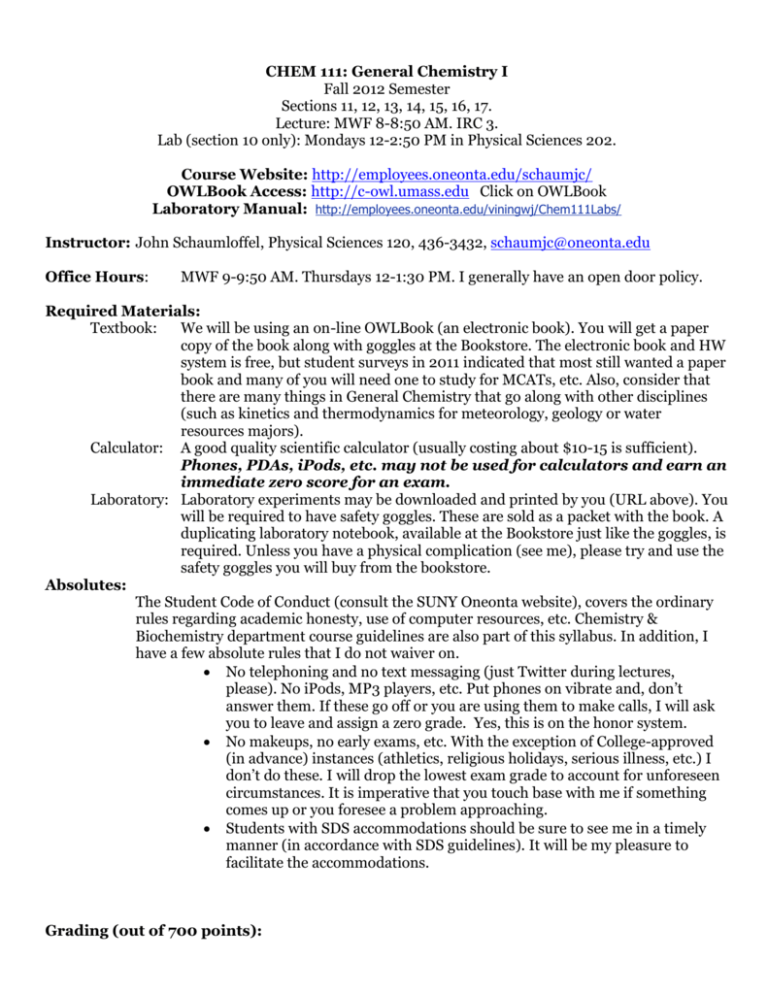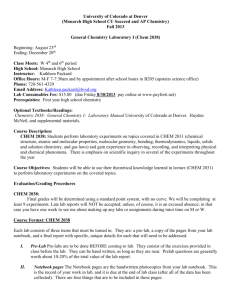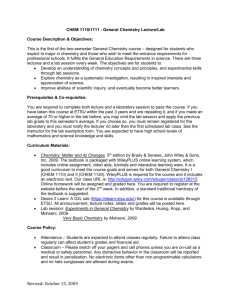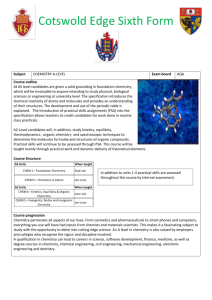CHEM 111 (Fall 2012) Syllabus
advertisement

CHEM 111: General Chemistry I Fall 2012 Semester Sections 11, 12, 13, 14, 15, 16, 17. Lecture: MWF 8-8:50 AM. IRC 3. Lab (section 10 only): Mondays 12-2:50 PM in Physical Sciences 202. Course Website: http://employees.oneonta.edu/schaumjc/ OWLBook Access: http://c-owl.umass.edu Click on OWLBook Laboratory Manual: http://employees.oneonta.edu/viningwj/Chem111Labs/ Instructor: John Schaumloffel, Physical Sciences 120, 436-3432, schaumjc@oneonta.edu Office Hours: MWF 9-9:50 AM. Thursdays 12-1:30 PM. I generally have an open door policy. Required Materials: Textbook: We will be using an on-line OWLBook (an electronic book). You will get a paper copy of the book along with goggles at the Bookstore. The electronic book and HW system is free, but student surveys in 2011 indicated that most still wanted a paper book and many of you will need one to study for MCATs, etc. Also, consider that there are many things in General Chemistry that go along with other disciplines (such as kinetics and thermodynamics for meteorology, geology or water resources majors). Calculator: A good quality scientific calculator (usually costing about $10-15 is sufficient). Phones, PDAs, iPods, etc. may not be used for calculators and earn an immediate zero score for an exam. Laboratory: Laboratory experiments may be downloaded and printed by you (URL above). You will be required to have safety goggles. These are sold as a packet with the book. A duplicating laboratory notebook, available at the Bookstore just like the goggles, is required. Unless you have a physical complication (see me), please try and use the safety goggles you will buy from the bookstore. Absolutes: The Student Code of Conduct (consult the SUNY Oneonta website), covers the ordinary rules regarding academic honesty, use of computer resources, etc. Chemistry & Biochemistry department course guidelines are also part of this syllabus. In addition, I have a few absolute rules that I do not waiver on. No telephoning and no text messaging (just Twitter during lectures, please). No iPods, MP3 players, etc. Put phones on vibrate and, don’t answer them. If these go off or you are using them to make calls, I will ask you to leave and assign a zero grade. Yes, this is on the honor system. No makeups, no early exams, etc. With the exception of College-approved (in advance) instances (athletics, religious holidays, serious illness, etc.) I don’t do these. I will drop the lowest exam grade to account for unforeseen circumstances. It is imperative that you touch base with me if something comes up or you foresee a problem approaching. Students with SDS accommodations should be sure to see me in a timely manner (in accordance with SDS guidelines). It will be my pleasure to facilitate the accommodations. Grading (out of 700 points): Item OWL Assignments Points 150 OWLBook Math & Practice Bonus Exams Laboratory Final Exam 20 300 100 150 # Points >640 570-639 500-569 430-499 <430 Comments Failure to do well in OWL lead to most CHEM 111 D & E Grades in Fall 2011. FREE POINTS!! Best 3 @ 100 points each Best 10 @ 10 points each 150 points Letter Grade (+/- to be determined) A B C D (I don’t do D+ or D-) E Be aware that the policy of the Department of Chemistry & Biochemistry is to require a C- or higher grade in pre-requisite courses. As a result, you will need a C- or higher in order to enroll in CHEM 112, CHEM 226 or any other CHEM course with 111 as a pre-requisite. You will also need to pass the laboratory, by earning 60 points or more (60%) in order to pass the class (regardless of any other achievements). OWLBook Access and Use: Refer to the OWLBook Student Quick Start Guide (emailed to you or available on my course website). OWL is a CRITICAL part of the course, both the book and the homework system (which are integrated). In Fall 2011, roughly 20% of the students taking General Chemistry got D & E grades (which means that CHEM 111 will not count as a pre-requisite for other CHEM courses). Most of the students who received D & E grades did not complete or spend much time on the OWL assignments. Some OWL hints: 1. Until the due date for an assignment, you may repeat the assignments as many times as you like without penalty. So, there is no reason to think you can’t get all or most of the OWL points. 2. OWL really is at the center of learning in this course. While OWL does take time and has some peculiarities that can be frustrating, it allows you to work on homework almost anywhere and at almost anytime. Also, you can get immediate feedback through the system that I might not be able to get to you right away. Your primary out-of-course work for the lecture should be reading the OWLBook, doing the tutorials in it and the OWLBook assignments. Expect 6-8 hours/week of work outside the lecture (plus a little for the lab). 3. You should do OWL assignments in a notebook (at least scratch work). The reason for this is to make notes, and process the problem through your brain and into your hands while writing out at least some of the problems. A notebook can also help me help you if you come to my office or have questions in class. I suggest a cheap composition notebook (one that is $1-$3), so all of the pages stay together. Notebook work is important, because exams will be given in the “classical manner”, combining mostly multiple choice with a little short answer. Topic/Schedule: Note that specific dates for specific topics/exams are tentative and will be modified as the course progresses. The best way to have accurate information and to be prepared is to attend EACH and EVERY lecture!! I will be taking attendance from time to time using your phones, iPads or other Smart devices (more info to come). Week Date(s) OWLBook Chapter & Topics Comments 1-2 8/22-8/31 Chapter 1: Introduction, General Become familiar with the Principals of Chemistry, Calculations OWLBook and how to complete and Mathematics the OWL assignments Chapter 2: Elements and Compounds 3 9/3-9/7 Chapter 2: Elements and Compounds 4 9/10-9/14 Chapter 3: Stoichiometry 5 9/17-9/21 Chapter 3: Stoichiometry 6 9/24 Exam #1 in Class on Monday Exam #1. Break starts after the end of classes on Tuesday. 7 10/1 – 10/5 Chapter 4: Chemical Reactions and Solution Stoichiometry 8 10/8 – 10/12 Chapter 5: Thermochemistry 9 10/15 – 10/19 Chapter 6: Electromagnetic Radiation Exam #2 on 10/15 and Atomic Structure 10 10/22-10/26 Chapter 6: Electromagnetic Radiation and Atomic Structure Chapter 7: Electronic Configurations and Atomic Properties 11 10/29-11/2 Chapter 7: Electronic Configurations and Atomic Properties Chapter 8: Covalent Bonding and Molecular Structure 12 11/5-11/9 Chapter 8: Covalent Bonding and Molecular Structure 13 11/12-11/16 Chapter 9: Theories of Chemical Exam #3 on 11/16. Break starts Bonding after the end of classes on Friday. 14 11/26-11/30 15 12/3-12/7 Chapter 9: Theories of Chemical Bonding Finals Week Exam #4 on 12/7. The final exam will be at the time scheduled by the Registrar (TBD). I strongly suggest you not make any end-of-semester travel plans until you have checked that schedule. You can not skip comprehensive final exam without receiving a zero grade for it. If you are satisfied with your performance on the first three exams, you may skip the fourth. I will take the best 3 exams and there is no penalty for “just skipping one”. I suggest trying to “save it” until the last exam. Laboratory Notes (Labs Start the Week of 8/27/12): You can download (about 1.8 Mb), a slow download, the lab manual using the link on the first page. The lab manual is provided at no cost and will really only take a little from your print quota. Each week, on Monday, I will discuss the upcoming laboratories briefly. A tentative schedule of laboratories and more very useful info, at this webpage: http://employees.oneonta.edu/viningwj/Chem111Labs/ SUNY Oneonta Undergraduate Catalog Course Description: CHEM 111 General Chemistry I 4 s.h. Studies chemical principles, with emphasis on stoichiometric relationships; the kinetic molecular theory of gases, atomic theory, chemical bonding, periodicity, solutions and electrolytes, and redox reactions. Includes lab. (LA, NL2) Prerequisite: high school chemistry. Chemistry & Biochemistry Program Student Learning Outcomes: Some of these are emphasized more in CHEM 111 and some less. The outcomes are a general list of how you may be evaluated on the specific topics we will consider, and not an indication of any specific question you would be asked at any given time. Student Learning Outcome Students will demonstrate an understanding of chemical elements and inorganic compounds, their properties, reactions and uses. Students will demonstrate an understanding of organic compounds, their properties, reactions and uses. Students will demonstrate an understanding of what controls chemical stability and reactivity, reaction kinetics and how to detect and analyze chemical reactions. Students will learn and practice basic laboratory safety and chemical hygiene procedures. Students will exhibit a working knowledge of classical and modern analytical techniques and instrumentation, and understand their uses and limitations. Students will gain experience in the use of computers for chemical simulation and computation, data acquisition, and data analysis. Students will demonstrate knowledge of the models chemists use to understand matter and energy at the atomic, molecular and macromolecular dimensions. Students will exhibit an understanding of the process of science as inquiry, including the role of collaboration and the evolving nature of scientific knowledge as it applies to chemistry. Students will demonstrate competence in analytical thinking and critical analysis of chemical literature. General Education NL2 Attribute Student Learning Outcomes: These student learning outcomes are germane to all NL2 General Education attribute courses at SUNY Oneonta. Students will demonstrate: Understanding of the methods scientists use to explore natural phenomena, including observation, hypothesis development, measurement and data collection, experimentation, evaluation of evidence, and employment of mathematical analysis; and Application of scientific data, concepts, and models in one of the natural sciences. Emergency Evacuation/Shelter-in-Place Procedures: In the event of an emergency evacuation (i.e., fire or other emergency), our laboratory classes meeting in the physical sciences building are directed to reassemble at the Chase Gymnasium so that all persons can be accounted for. Evacuation from our lecture hall in IRC is to the Fine Arts Theater. Complete details of the emergency evacuation, shelter-in-place, and other emergency procedures can be found at http://www.oneonta.edu/security. Americans with Disabilities Act Statement § Students Diagnosed with a Disability—All individuals who are diagnosed with a disability are protected under the Americans with Disabilities Act, and Section 504 of the Rehabilitation Act of 1973. As such, you may be entitled to certain accommodations within this class. If you are diagnosed with a disability, please make an appointment to meet with Student Disability Services (SDS), 209 Alumni Hall, ext. 2137. All students with the necessary supporting documentation will be provided appropriate accommodations as determined by the SDS Office. It is entirely your responsibility to contact SDS and concurrently supply me with your accommodation plan, which will inform me exactly what accommodations you are entitled to. You will only receive accommodations once you provide me with an SDS accommodation plan. Any previously recorded grades will not be changed. Department of Chemistry and Biochemistry Policy on Course Attendance, Performance, Participation and Behavior 1. Students are expected to attend all scheduled course sessions and should be prepared by reading in advance any relevant material assigned or provided. Participation (defined by interacting with the instructor, working problems at the board, individually or in groups, using personal response “Clicker” systems and other mechanisms defined in the syllabus) is expected. 2. Students are reminded that instructors are not required to accept assignments submitted late, except in instances allowed according to College policies. College Policies as defined in the Student Code of Conduct apply to lecture, recitation and laboratory portions of all courses. 3. Laboratories are an integral part of education in chemistry courses. As a result, participation in all laboratories scheduled for a course is expected. Unless alternate activities are scheduled, students can expect that their laboratory section will meet each week, and failure to attend laboratories may lead to failure in the course. 4. The minimum acceptable grade for a chemistry course prerequisite is a C-. For example, a student with a D+ in General Chemistry I may not enroll in General Chemistry II. This standard applies to all Chemistry prerequisites for all Chemistry courses. 5. The laboratory for a course must be passed, normally by earning 60% of the available score or points for the laboratory, in order to pass the course. Exceptions may be noted in the course syllabus. 6. Students are expected to bring to laboratory the laboratory manual (or printout of the experiment), a laboratory notebook (if required), a calculator, ruler or other materials as specified by the instructor or in the syllabus. 7. Students are not allowed to work in the laboratory without direct faculty supervision. 8. Unless announced in advance, SAFETY GOGGLES (WHICH PROVIDE A COMPLETE SEAL AROUND THE EYES AND ARE EQUIPPED WITH INDIRECT VENTS) ARE REQUIRED TO BE WORN AT ALL TIMES IN THE LABORATORY. STUDENTS ARE REQUIRED TO PROVIDE THEIR OWN SAFETY GOGGLES. 9. Open-toed shoes (e.g. sandals, “Birkenstocks”, flip-flops, etc), unrestrained long hair, excessively loose clothing and other items, which may be easily ignited or snag on apparatus are not allowed. 10. Food, drink, candy, cosmetics, tobacco products, etc. are not allowed in the laboratory. 11. Students are expected to be attentive to the material and any experiments and apparatus in the laboratory. The following must be turned off and stored away from the laboratory bench while in laboratories: Portable music players (e.g. iPods, MP3 players and the like) Cellular telephones, pagers, text messaging devices and the like Other portable electronic devices as defined by the laboratory instructor 12. Horseplay, practical jokes, “goofing around” or interfering with other students’ work is not allowed in the laboratory. 13. Students should not expect to be able to makeup missed laboratory sessions or experiments. If a makeup session is possible, it will be at the discretion of the laboratory instructor and will normally be during the same week as the missed laboratory section. 14. Students will not be permitted to work in any laboratory section other than that they are registered for unless they have the written approval of both their regular instructor AND the instructor in the section they wish to enter. Course instructors may modify these guidelines as necessary to meet the requirements of individual courses or chemical specialties in consultation with the Department Chairperson. Students should expect to receive a copy of these guidelines in their course syllabus or be given a copy by the course instructor (either in paper form or by electronic mail). Adopted by the Department of Chemistry & Biochemistry on 16-March-2009 and to be included in each course syllabus beginning in Fall 2009. Modification of Policy #4 approved on August 20, 2010.






